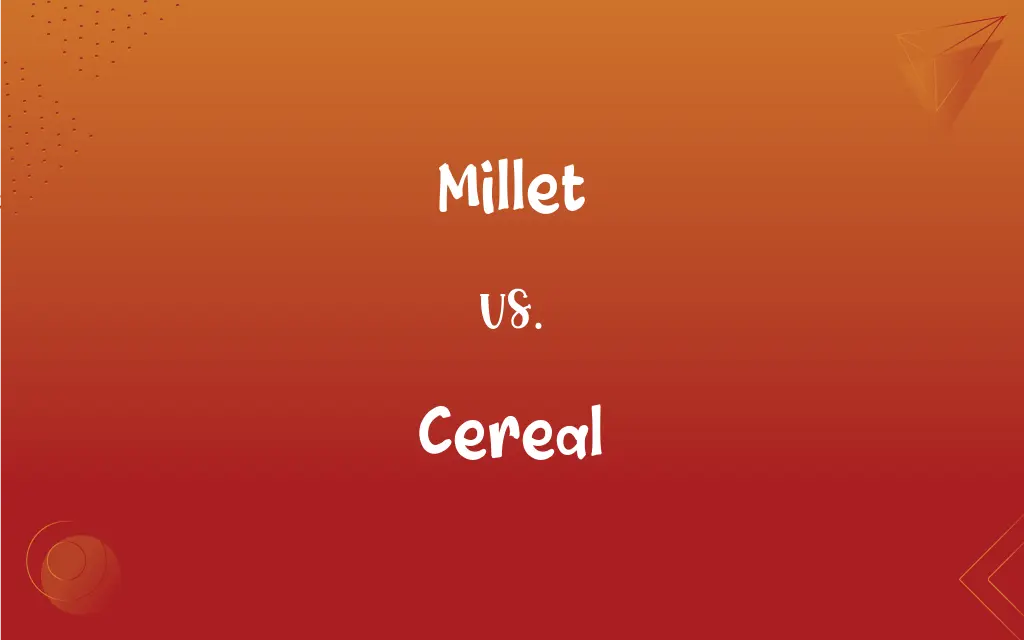Millet vs. Cereal: What's the Difference?
Edited by Aimie Carlson || By Harlon Moss || Published on February 9, 2024
Millet refers to small-seeded grasses widely grown as cereal crops, whereas cereal encompasses various grasses like wheat, rice, and corn, cultivated for their edible grains.

Key Differences
Millet encompasses a variety of small-seeded grasses that are cultivated as cereal crops, particularly in arid and semiarid regions. In contrast, cereals are a broader category of grasses cultivated for their edible grains, including wheat, rice, corn, and millets.
Millets are renowned for their ability to thrive in harsh, drought-prone environments, making them vital for food security in such areas. Cereals, while also adaptable, include crops like rice and wheat that often require more specific growing conditions, such as more water and fertile soil.
Millets are highly nutritious, rich in fiber, vitamins, and minerals, and are often gluten-free, making them a suitable choice for people with gluten intolerance. Cereals as a whole vary widely in their nutritional content, with some like oats and quinoa being highly nutritious, while others like refined wheat have lower nutritional value.
Millets are used in a variety of cuisines, often in the form of whole grains or flour, popular in porridges, bread, and traditional dishes in Asia and Africa. Cereals are more globally widespread, used in a multitude of forms, from breakfast cereals to staples like bread, pasta, and rice dishes.
Millets hold significant cultural importance in many parts of the world, particularly in Asia and Africa, where they are traditional staples. Cereals like wheat, rice, and corn are of immense global economic importance, forming the staple food for a large proportion of the world's population.
ADVERTISEMENT
Comparison Chart
Definition
Small-seeded grasses grown as cereal crops
Various grasses cultivated for edible grains
Climate Adaptability
Thrives in arid, harsh environments
Requires specific conditions, varies by type
Nutritional Content
High in fiber, vitamins, minerals, gluten-free
Varies widely, some highly nutritious, some less
Usage
Whole grains, flour, traditional dishes
Breakfast cereals, bread, pasta, staple foods
Economic & Cultural Role
Important in specific regions like Asia, Africa
Globally significant, staple in many diets
ADVERTISEMENT
Millet and Cereal Definitions
Millet
Millets are known for their drought resistance and are grown in arid regions.
In the arid landscape, millet thrives where other crops fail.
Cereal
Cereal refers to any grass cultivated for the edible components of its grain.
Wheat, a type of cereal, is a primary ingredient in bread making.
Millet
Many varieties of millet, like pearl and finger millet, are important in traditional diets.
Pearl millet is widely consumed in India for its high nutrient content.
Cereal
Cereal grains are a primary source of carbohydrates and a staple in human diets.
His diet included cereal grains like oats and barley for energy.
Millet
Millet is a group of highly nutritious, small-seeded grasses used as cereal crops.
Millet is often ground into flour for making traditional flatbread.
Cereal
Cereals like rice, wheat, and corn are staple foods in various cultures worldwide.
Rice, a popular cereal, is the main dish in many Asian cuisines.
Millet
Millet is often used in gluten-free recipes due to its absence of gluten.
She baked gluten-free bread using millet flour for her allergy-sensitive family.
Cereal
Cereal cultivation is a significant part of agriculture, with extensive economic importance.
The country's economy heavily relies on cereal crop exports like corn and wheat.
Millet
Millet is a staple food in many parts of Asia and Africa, valued for its nutritional content.
Millet porridge is a common breakfast in several African countries.
Cereal
Breakfast cereals, made from processed cereal grains, are popular in Western diets.
She had a bowl of cereal made from toasted whole wheat every morning.
Millet
Any of various annual grasses with small grains that are harvested for food, livestock feed, and birdseed, especially proso millet.
Cereal
A grass such as wheat, oats, or corn, the starchy grains of which are used as food.
FAQs
Are Millets gluten-free?
Yes, most millets are gluten-free, making them suitable for gluten-intolerant diets.
Where is Millet commonly grown?
Millet is commonly grown in arid and semiarid regions of Asia and Africa.
What are common types of Cereals?
Common cereals include wheat, rice, corn, oats, barley, and rye.
What is Millet?
Millet refers to small-seeded grasses used as cereal crops, known for their nutritional value.
What is the difference between whole grain and refined Cereal?
Whole grain cereals contain all parts of the grain, while refined cereals have the bran and germ removed.
What does Cereal mean?
Cereal refers to plants from the grass family cultivated for their edible grains, like wheat, rice, and corn.
Is Cereal a staple food globally?
Yes, cereals like rice, wheat, and corn are staple foods in many parts of the world.
What is the nutritional value of Millet?
Millet is rich in fiber, vitamins, minerals, and is a good source of protein.
Can Millet be used for baking?
Yes, millet can be ground into flour and used for baking bread and other items.
How are Cereals used in diets?
Cereals are used in various forms, from breakfast cereals to staples like bread, pasta, and rice.
What is the main carbohydrate source in Cereals?
The main carbohydrate source in cereals is starch, present in the grains.
What is the role of Cereals in agriculture?
Cereals play a central role in agriculture, being a primary crop in many countries.
What are the health benefits of consuming Cereals?
Consuming cereals provides essential nutrients, aids in digestion, and provides energy.
Is Millet good for weight loss?
Yes, millet is good for weight loss due to its high fiber content and low glycemic index.
Does Millet need a lot of water to grow?
No, millet requires relatively little water, making it suitable for dry regions.
How do Millets benefit the environment?
Millets require less water and can grow in poor soil conditions, making them environmentally sustainable.
Are Cereals part of a balanced diet?
Yes, cereals are a crucial part of a balanced diet, providing essential nutrients and energy.
What dishes can be made from Millet?
Millet can be used in porridges, bread, salads, and traditional dishes like millet pilaf.
Can Millet be eaten by diabetics?
Yes, millet is suitable for diabetics due to its low glycemic index and high fiber.
How do Cereals contribute to world food security?
Cereals are a major food source worldwide, contributing significantly to global food security.
About Author
Written by
Harlon MossHarlon is a seasoned quality moderator and accomplished content writer for Difference Wiki. An alumnus of the prestigious University of California, he earned his degree in Computer Science. Leveraging his academic background, Harlon brings a meticulous and informed perspective to his work, ensuring content accuracy and excellence.
Edited by
Aimie CarlsonAimie Carlson, holding a master's degree in English literature, is a fervent English language enthusiast. She lends her writing talents to Difference Wiki, a prominent website that specializes in comparisons, offering readers insightful analyses that both captivate and inform.







































































